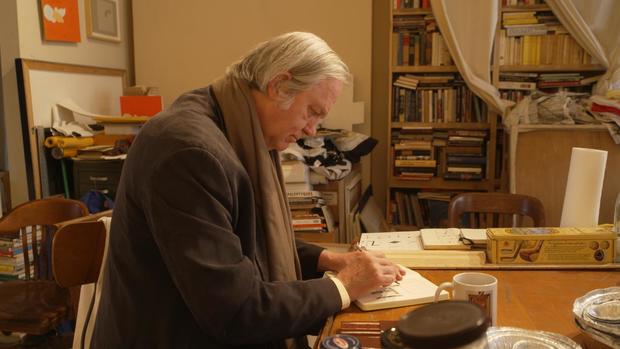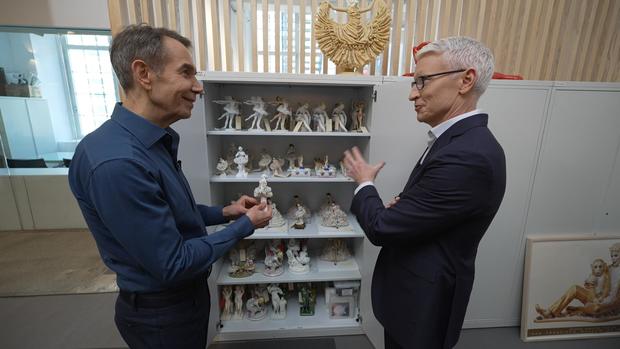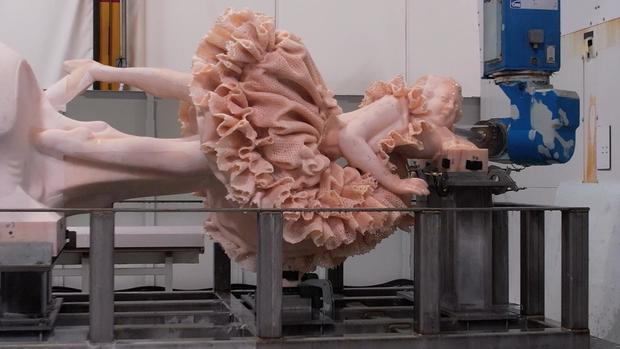Art
Jeff Koons and Anderson Cooper | 60 Minutes
Jeff Koons is one of the most prominent and polarizing art stars in the world. Perhaps you’ve seen one of his giant balloon dog sculptures or the stainless steel inflatable rabbit he made that resold for $91 million a few years ago- the highest price ever paid at auction for a work by a living artist. I bought a much less expensive work of his at a charity auction about 10 years ago. His creations may look simple, but they can take decades to make and often push the boundaries of technology and sometimes taste. Critics may scoff at times but that’s nothing new. Jeff Koons has been controversial since he first started showing his art more than 40 years ago.
You’ll find the largest collection of Jeff Koons’ work at the Broad Museum in Los Angeles. Visiting it is like showing up at a strange children’s party long after the kids have gone to bed.
There’s a giant painting of a party hat, a porcelain Michael Jackson and his chimp Bubbles- a kind of pop culture pieta. The Hulk even makes an appearance.
The star attraction- a 10-foot tall, stainless steel “Balloon Dog” sculpture.
Koons showed it to us after hours.
Jeff Koons: We had to make machines to make this work. They didn’t exist.
It may look like it’s filled with air, but “Balloon Dog” weighs more than a ton and took Jeff Koons six years to make.
60 Minutes
Jeff Koons: I started with a balloon and I blew it up. I twisted a balloon dog.
Anderson Cooper: Did you know how to make a balloon dog?
Jeff Koons: No, I just got a little book. And I saw how you do it. So I twisted up. I probably made about 50 of ’em. I made a mold of it. And then that was used to make the stainless steel pieces. You know, originally, when I made this piece, I thought that I could make it for about $300,000. Which still, that’s a lot of money. But it ended up just to create the piece ended up costing me $1.6 [million]
Anderson Cooper: Wow.
Jeff Koons: And that was more than what I had sold the work for.
That’s classic Koons. He is famous for going over budget and his obsessive attention to detail is legendary. He spent 20 years figuring out how to turn this mass of aluminum into a ten-foot tall pile of Play-Doh.
To get these basketballs to appear suspended in air, he enlisted the help of a Nobel prize winning physicist…
…and he used more than 60,000 living flowers to create this 40-foot sculpture of a puppy.
Koons often takes famous characters or artworks and plays with them- adding a gazing ball to the Mona Lisa. Or he elevates everyday things, making them larger, shinier or surreal versions of themselves.
Jeff Koons: The Rabbit’s from ’86.
Anderson Cooper: ’86.
Like that “Rabbit” resold a few years ago for $91 million, he made four that look at first as if they’re just plastic inflatables. But they’re highly polished stainless steel and weigh about 150 pounds.
Jeff Koons: It’s iconic because it can represent so many different things. I can think of Easter. I can think of a politician with a kind of, a microphone, somebody making proclamations. I can think of a Playboy rabbit. But I think one of the most important things to me, the reason it’s reflective, and reflecting you, reflecting me, you know, the viewer finishes a work of art. It’s, it, it’s about your feelings, your experiences. It’s about your potential.
60 Minutes
Maybe you’re thinking Jeff Koons sounds like a phony self-help prophet. Plenty of critics do, but he does see art as something that can help people have a personal transformation.
Jeff Koons: Art can be anything. I mean, it really can be. My personal experience of art is that you just don’t have to bring anything to it other than yourself.
Anderson Cooper: So your message to people is you don’t need to have a thesis in art history to interact with art and what you feel from it is valid.
Jeff Koons: It’s as valid as anybody else could experience.
Anderson Cooper: Why balloon dogs? Why gazing balls? An inflatable rabbit?
Jeff Koons: Memories. You know around Easter time, I would see a lot of inflatable rabbits in the yards. I would see gazing balls in people’s yards, in their gardens. Our neighbors who do that, I mean how generous they are for us that we’re just driving by or walking by, and we can look. And we can have a little awe and wonderment just for that, a second. To me they’re symbols of cultural history.
Koons grew up outside York, Pennsylvania, in a rural community, where you can still find gazing balls in people’s yards. He has eight children, six with his second wife Justine, to whom he’s been married for 21 years. They still live part time in Pennsylvania, in Koons’ grandparents house, part of an 800-acre farm where they raise horses and cows.
Anderson Cooper: I think most people don’t envision that this is the life you have as a world-famous artist.
Jeff Koons: Yeah. Well, you know, you know, I’m very involved with my, my work. But on the weekends and summers, holidays, this is a really important part of my life.
Koons has been drawing and painting since childhood. In 1974 while studying art in college, his mother helped him meet one of his favorite surrealist painters.
Jeff Koons: My mother called me and she said, “I just saw in a magazine that Salvador Dali spends half his year in New York City at the St. Regis Hotel.” And I thought, oh, OK, maybe, you know, I’ll call and, and –
Anderson Cooper: Wait a minute. You just thought you’d call him?
Jeff Koons: I called the St. Regis. I asked for Salvador Dali’s room and they put me through. You know, I was quite nervous, but I told him I was a fan and that I would enjoy very much to meet him. And he said, “Can you come to New York this weekend on Saturday?” And I said yes. He said, “Be in the lobby at 12 o’clock and I’ll meet you then.” And he was spectacular.
Anderson Cooper: It would never have occurred to me to, like, just call Salvador Dali at his hotel room.
Jeff Koons: I had nothing to lose, you know?
Koons and Dali spent the afternoon together, and at the end of it, he asked the world-renowned artist to pose for this picture.
Jeff Koons: I remember he put his mustache up and he was telling me, you know, “Kid, hurry up. I, I can’t hold this pose all day.” But I left New York that evening feeling like I could do this.
After finishing school, he hitchhiked to New York and started making art in his Lower East Side apartment- buying cheap plastic inflatables and putting them on mirrors. Koons had grand ambitions but he needed cash to realize them.
Jeff Koons: So eventually I became licensed and registered to sell commodities and mutual funds. And so, you know, that’s what I started to do to be able to make more money to make the works.
Anderson Cooper: That’s not a career move a lot of artists make.
Jeff Koons: You know, I did it only that I could make enough money to make my vacuum cleaner pieces.
The vacuum cleaners he’s talking about were what first got him noticed in 1980. He bought about 20 brand new vacuums and displayed them in cases with fluorescent lights. It was part of a series called “The New.”
Jeff Koons: I was showing them for their newness, that this was a brand new object, it was never used, never turned on. You can see that it’s clean, it’s pristine, its lungs are pure. And there’s also some sensual aspects to it, too. They can–
Anderson Cooper: Sensual aspects?
Jeff Koons: Sensual, I mean, you have the handle, and you have the bag right there. It could be looked at as masculine, or you can look at it and say, “Oh, you know, the bag is the womb.”
Art definitely is in the eye of the beholder.
Anderson Cooper: What did you think of Jeff Koons as an artist when he first sort of came on the scene?
60 Minutes
Robert Storr: I was interested in him, and I also was kind of repulsed by him.
Robert Storr, former dean at the Yale School of Art, was a curator at the Museum of Modern Art in New York when it acquired some of Koons’ vacuums in 1996.
Robert Storr: I think some of the work is really unpleasant. But it doesn’t mean it’s not serious.
Anderson Cooper: What’s unpleasant about it?
Robert Storr: The imagery is, is vulgar, okay? Now, vulgar means many things. It means of the people rather than of the elites.
Anderson Cooper: So it’s taking an object which the New York elites might look at and think, “Oh, that’s tacky. That’s”–
Robert Storr: Yeah–
Anderson Cooper: “That’s trashy. That’s something you buy in, in a gift shop.” And it’s blowing it up and making it perfect and saying that this has value?
Robert Storr: It has meaning, not necessarily value, but it has meaning.
Anderson Cooper: What is the message of that?
Robert Storr: The message is that it is there to be embraced, that it is not to be mocked, that one should not be smugly sure of one’s own taste to the point of denying the possibility of other tastes.
Anderson Cooper: And is he being honest about that?
Robert Storr: I think he’s being totally honest. And I think that he has made all of that fair game in a way that we have not seen since Warhol.
Like Andy Warhol, Jeff Koons has a factory of sorts. With an assembly line of painters meticulously following his instructions, and dozens of digital assistants, sculptors, and craftsmen all over the world helping make his complex pieces, which are often inspired by very simple things.
Anderson Cooper: This is like a very modern grandmother’s closet.
60 Minutes
Turns out Koons was fascinated by his grandparent’s porcelain figurines as a child and has collected hundreds of them.
Anderson Cooper: Where did you find this?
Jeff Koons: I found it online.
He decided to make this $150 ballerina into a multimillion dollar 8-foot-tall marble sculpture, but it wound up taking him 12 years.
First he used a CAT scan machine to digitally map every detail of the figurine inside and out.
Then it took him five years, and the help of MIT scientists, to begin translating all those details into instructions for machines to carve the sculpture.
The actual carving took another seven years.
We went with Koons to a workshop in Pennsylvania to check on the progress, and found Ayami Aoyama and her team carefully polishing the ballerina by hand.
Anderson Cooper: Do you have a sense of how many hours of work is done on a piece?
Ayami Aoyama: 33,000 hours.
Anderson Cooper: 33,000 hours?
Ayami Aoyama: Hours. For just the handwork.
Anderson Cooper: It must be exhausting. I mean, the level of detail and monotony and difficulty of it is incredible.
Ayami Aoyama: Yeah, it is like really unique job I would say.
Anderson Cooper: That looks like a sort of a dental tool. What, what is this?
Ayami Aoyama: Yeah, that’s nail polisher that, you know, that ladies actually use.
Anderson Cooper: Is it? Really?
Ayami Aoyama: Yeah.
60 Minutes
You’ll notice Jeff Koons isn’t doing the sculpting or painting. He comes up with the ideas and sets the standards, but his artisans do the labor, which has led to criticism- including from our own Morley Safer.
Thirty years ago, Morley did a story critiquing contemporary art and likened Koons to a P.T. Barnum selling to suckers.
Morley Safer (archives): “He doesn’t actually paint or sculpt, he commissions craftsman to do that or he goes shopping for basketballs and vacuum cleaners.”
Anderson Cooper: Is that a legitimate criticism?
Jeff Koons: It’s a legitimate criticism if you look at art in a way that you’re kind of want everything to be done by the artist themselves. But it becomes very limited, what you can do within one life if you’re being responsible for everything. It’s like the production of this program right now. Anderson, if you had to be responsible for the lighting, if you had to be responsible for editing.
Anderson Cooper: If I was responsible for the lighting, you wouldn’t, we wouldn’t see you or myself.
Jeff Koons: But if you’d have to be responsible for everything, I mean, how many programs would you be able to create? I’ve designed, worked on the systems so that the whole process, at the end of the day, it’s as if every mark was made by myself.
At 68, Koons has reached a level of commercial success few artists ever imagine. He’s helped design cars for BMW, an album cover for Lady Gaga, even a superyacht.
And later this year, he hopes to create a permanent art exhibit on the moon. He’s made 125 small stainless steel moon sculptures and mounted them on a lunar lander that’ll hitch a ride aboard a SpaceX rocket.
Anderson Cooper: Is there something about the atmosphere on the moon that would affect the lifespan of a work?
Jeff Koons: Yeah. Almost everything. You know, you have tremendous radiation. You have the temperature change, at least 250 degrees difference from night to day. One of the most inhospitable environments that, you know, you could imagine for a work of art.
The moon sculptures are for sale, of course, along with an NFT, or non-fungible token, which serves as digital proof your artwork is actually up there. You’ll also get one of these larger moons to show off here on Earth. He won’t say how much it’ll cost you, but with Jeff Koons it’s a safe bet the price tag will be out of this world.
Produced by Nichole Marks. Associate producers: John Gallen, David M. Levine and Katie Kerbstat Jacobson. Broadcast associates: Eliza Costas and Annabelle Hanflig. Edited by Michael Mongulla.

Art
Calvin Lucyshyn: Vancouver Island Art Dealer Faces Fraud Charges After Police Seize Millions in Artwork

In a case that has sent shockwaves through the Vancouver Island art community, a local art dealer has been charged with one count of fraud over $5,000. Calvin Lucyshyn, the former operator of the now-closed Winchester Galleries in Oak Bay, faces the charge after police seized hundreds of artworks, valued in the tens of millions of dollars, from various storage sites in the Greater Victoria area.
Alleged Fraud Scheme
Police allege that Lucyshyn had been taking valuable art from members of the public under the guise of appraising or consigning the pieces for sale, only to cut off all communication with the owners. This investigation began in April 2022, when police received a complaint from an individual who had provided four paintings to Lucyshyn, including three works by renowned British Columbia artist Emily Carr, and had not received any updates on their sale.
Further investigation by the Saanich Police Department revealed that this was not an isolated incident. Detectives found other alleged victims who had similar experiences with Winchester Galleries, leading police to execute search warrants at three separate storage locations across Greater Victoria.
Massive Seizure of Artworks
In what has become one of the largest art fraud investigations in recent Canadian history, authorities seized approximately 1,100 pieces of art, including more than 600 pieces from a storage site in Saanich, over 300 in Langford, and more than 100 in Oak Bay. Some of the more valuable pieces, according to police, were estimated to be worth $85,000 each.
Lucyshyn was arrested on April 21, 2022, but was later released from custody. In May 2024, a fraud charge was formally laid against him.
Artwork Returned, but Some Remain Unclaimed
In a statement released on Monday, the Saanich Police Department confirmed that 1,050 of the seized artworks have been returned to their rightful owners. However, several pieces remain unclaimed, and police continue their efforts to track down the owners of these works.
Court Proceedings Ongoing
The criminal charge against Lucyshyn has not yet been tested in court, and he has publicly stated his intention to defend himself against any pending allegations. His next court appearance is scheduled for September 10, 2024.
Impact on the Local Art Community
The news of Lucyshyn’s alleged fraud has deeply affected Vancouver Island’s art community, particularly collectors, galleries, and artists who may have been impacted by the gallery’s operations. With high-value pieces from artists like Emily Carr involved, the case underscores the vulnerabilities that can exist in art transactions.
For many art collectors, the investigation has raised concerns about the potential for fraud in the art world, particularly when it comes to dealing with private galleries and dealers. The seizure of such a vast collection of artworks has also led to questions about the management and oversight of valuable art pieces, as well as the importance of transparency and trust in the industry.
As the case continues to unfold in court, it will likely serve as a cautionary tale for collectors and galleries alike, highlighting the need for due diligence in the sale and appraisal of high-value artworks.
While much of the seized artwork has been returned, the full scale of the alleged fraud is still being unraveled. Lucyshyn’s upcoming court appearances will be closely watched, not only by the legal community but also by the wider art world, as it navigates the fallout from one of Canada’s most significant art fraud cases in recent memory.
Art collectors and individuals who believe they may have been affected by this case are encouraged to contact the Saanich Police Department to inquire about any unclaimed pieces. Additionally, the case serves as a reminder for anyone involved in high-value art transactions to work with reputable dealers and to keep thorough documentation of all transactions.
As with any investment, whether in art or other ventures, it is crucial to be cautious and informed. Art fraud can devastate personal collections and finances, but by taking steps to verify authenticity, provenance, and the reputation of dealers, collectors can help safeguard their valuable pieces.
Art
Ukrainian sells art in Essex while stuck in a warzone – BBC.com
[unable to retrieve full-text content]
Ukrainian sells art in Essex while stuck in a warzone BBC.com

Source link
Art
Somerset House Fire: Courtauld Gallery Reopens, Rest of Landmark Closed
The Courtauld Gallery at Somerset House has reopened its doors to the public after a fire swept through the historic building in central London. While the gallery has resumed operations, the rest of the iconic site remains closed “until further notice.”
On Saturday, approximately 125 firefighters were called to the scene to battle the blaze, which sent smoke billowing across the city. Fortunately, the fire occurred in a part of the building not housing valuable artworks, and no injuries were reported. Authorities are still investigating the cause of the fire.
Despite the disruption, art lovers queued outside the gallery before it reopened at 10:00 BST on Sunday. One visitor expressed his relief, saying, “I was sad to see the fire, but I’m relieved the art is safe.”
The Clark family, visiting London from Washington state, USA, had a unique perspective on the incident. While sightseeing on the London Eye, they watched as firefighters tackled the flames. Paul Clark, accompanied by his wife Jiorgia and their four children, shared their concern for the safety of the artwork inside Somerset House. “It was sad to see,” Mr. Clark told the BBC. As a fan of Vincent Van Gogh, he was particularly relieved to learn that the painter’s famous Self-Portrait with Bandaged Ear had not been affected by the fire.
Blaze in the West Wing
The fire broke out around midday on Saturday in the west wing of Somerset House, a section of the building primarily used for offices and storage. Jonathan Reekie, director of Somerset House Trust, assured the public that “no valuable artefacts or artworks” were located in that part of the building. By Sunday, fire engines were still stationed outside as investigations into the fire’s origin continued.
About Somerset House
Located on the Strand in central London, Somerset House is a prominent arts venue with a rich history dating back to the Georgian era. Built on the site of a former Tudor palace, the complex is known for its iconic courtyard and is home to the Courtauld Gallery. The gallery houses a prestigious collection from the Samuel Courtauld Trust, showcasing masterpieces from the Middle Ages to the 20th century. Among the notable works are pieces by impressionist legends such as Edouard Manet, Claude Monet, Paul Cézanne, and Vincent Van Gogh.
Somerset House regularly hosts cultural exhibitions and public events, including its popular winter ice skating sessions in the courtyard. However, for now, the venue remains partially closed as authorities ensure the safety of the site following the fire.
Art lovers and the Somerset House community can take solace in knowing that the invaluable collection remains unharmed, and the Courtauld Gallery continues to welcome visitors, offering a reprieve amid the disruption.
-

 Sports18 hours ago
Sports18 hours agoArmstrong scores, surging Vancouver Whitecaps beat slumping San Jose Earthquakes 2-0
-

 News18 hours ago
News18 hours agoAs plant-based milk becomes more popular, brands look for new ways to compete
-

 News15 hours ago
News15 hours agoLabour Minister praises Air Canada, pilots union for avoiding disruptive strike
-

 News15 hours ago
News15 hours agoLooking for the next mystery bestseller? This crime bookstore can solve the case
-

 News18 hours ago
News18 hours agoLiberal candidate in Montreal byelection says campaign is about her — not Trudeau
-

 News18 hours ago
News18 hours agoB.C. victim’s family furious at no-fault insurance regime in motor-vehicle death case
-

 News18 hours ago
News18 hours agoAir Canada, pilots reach tentative deal, averting work stoppage
-

 News18 hours ago
News18 hours agoInflation expected to ease to 2.1%, lowest level since March 2021: economists





















